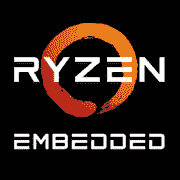AMD Ryzen Embedded R2514

AMD Ryzen Embedded R2514: Compact Power for Niche Tasks
Updated: March 2025
Introduction
The AMD Ryzen Embedded R2514 is a processor designed for embedded systems and compact solutions where energy efficiency and graphics integration are essential. Despite its modest TDP (15 W), the chip delivers adequate performance for a variety of tasks. In this article, we’ll explore who the R2514 is suitable for, how to utilize it, and what makes it stand out among competitors.
1. Key Specifications
Architecture and Process Technology
The R2514 is based on the Zen+ microarchitecture (codename Picasso), manufactured using GlobalFoundries’ 12nm process technology. While not the most modern process (in 2025, 5nm and 6nm chips dominate), the 12nm remains relevant for embedded solutions due to its balance of cost and reliability.
Performance
- 4 cores / 8 threads — suitable for multitasking, but not for heavy computational tasks.
- Base frequency: 2.1 GHz, maximum boost up to 3.7 GHz in turbo mode.
- L3 cache: 4 MB — a minimum for Zen+, but sufficient for light tasks.
- Graphics: Radeon Vega 8 (8 compute units, frequency up to 1200 MHz) — capable of running 1080p in less demanding games and videos.
Geekbench 6 Scores:
- Single-Core: 961 — comparable to Intel Core i3-10100.
- Multi-Core: 2594 — close to Ryzen 3 3200G, but lower than modern Ryzen 5 processors.
Key Features
- Low power consumption (15 W) — ideal for passive cooling.
- Integrated graphics — no need for a discrete graphics card.
- Support for ECC memory — critical for industrial systems.
2. Compatible Motherboards
Socket and Chipsets
The R2514 uses the FP5 socket (BGA), meaning the processor is soldered onto the motherboard. This limits upgrades but enhances reliability.
Recommended Boards:
- ASRock IMX-R2514 (AMD X300 chipset) — compact Mini-ITX with HDMI 2.0 and USB 3.2 Gen2. Price: ~$180.
- Advantech SOM-5992 (System-on-Module) — for industrial controllers.
Selection Tips:
- Look for boards with HDMI 2.0/DisplayPort support for 4K@60Hz.
- Check for M.2 NVMe support for fast storage.
3. Supported Memory Types
The R2514 supports DDR4-2400/2666 MHz in dual-channel mode. Capacity up to 64 GB (depends on the board).
Recommendations:
- For office tasks, 8–16 GB is sufficient.
- For media servers or virtualization — 32 GB.
- Choose modules with low voltage (1.2 V) to reduce heat.
Example: Crucial DDR4-2666 32 GB kit (2x16 GB) — $75.
4. Power Supplies
With a TDP of 15 W, a system with the R2514 consumes ~40–60 W (including storage, memory, and peripherals).
Suggestions:
- Power supplies rated 80–150 W with 80 Plus Bronze certification (e.g., Seasonic SSP-100ET).
- Fully passive systems can use PicoPSU (e.g., 120 W for $60).
5. Pros and Cons
Pros:
- Energy efficiency — suitable for 24/7 operation.
- Reliability — designed to operate from -40°C to +85°C.
- Vega 8 graphics — can play Dota 2 at medium settings (1080p, 50–60 FPS).
Cons:
- No support for PCIe 4.0 — only PCIe 3.0 x8.
- Limited motherboard options.
- Weak upgrade potential — the processor is soldered to the board.
6. Use Cases
Media Centers and HTPCs
The R2514 decodes 4K H.265 via Vega 8. Example: a system based on ASRock IMX-R2514 + Kodi — a silent cinema setup.
Office and Light Tasks
- Document processing, web browsing (20+ tabs), Zoom.
- Real-world experience: In a setup with 16 GB RAM and SSD, the system is "fast."
Industrial Systems
- Management of IoT devices, terminals in retail environments.
Gaming
- Skyrim SE (1080p, medium settings) — 45–55 FPS.
- CS:GO (1080p, low settings) — 70–90 FPS.
7. Comparison with Competitors
Intel Core i3-1215U (15 W)
- Intel Advantages: Higher single-core score (1102 in Geekbench 6).
- Disadvantages: UHD 64EU graphics are 20–30% weaker than Vega 8.
NVIDIA Jetson Orin Nano
- NVIDIA Advantages: AI accelerators, CUDA support.
- Disadvantages: No x86 compatibility, more expensive ($299).
8. Practical Assembly Tips
1. Case: Choose compact solutions (InWin Chopin, $90).
2. Cooling: Passive heatsink NoFan CR-80EH ($45).
3. Storage: WD Red SN700 500 GB NVMe ($55) — for reliability.
4. Networking: Add a Wi-Fi 6 module (Intel AX210, $25).
9. Final Conclusion: Who is the R2514 Suitable For?
- Compact PC Enthusiasts: Building a HTPC or mini-server.
- Businesses: Terminals, digital signage.
- Engineers: Industrial controllers with ECC support.
Processor Price: ~$150 (OEM supply).
Why R2514? It offers a balance of price, energy efficiency, and sufficient performance for niche tasks. If maximum power isn’t needed but stability and quiet operation are essential, this is an excellent choice.
This article is relevant as of March 2025. Prices are indicative for new devices in the USA.
Basic
CPU Specifications
Memory Specifications
GPU Specifications
Benchmarks
Compared to Other CPU
Share in social media
Or Link To Us
<a href="https://cputronic.com/en/cpu/amd-ryzen-embedded-r2514" target="_blank">AMD Ryzen Embedded R2514</a>